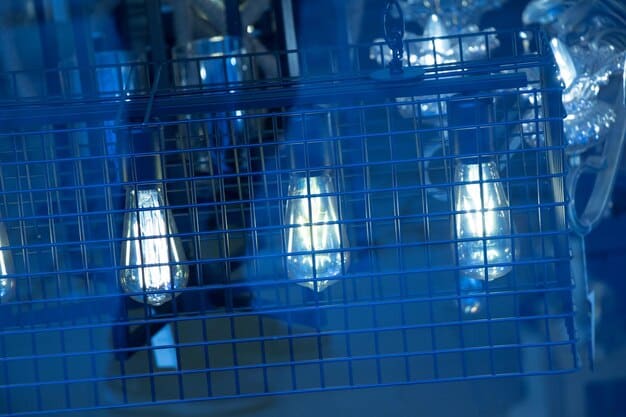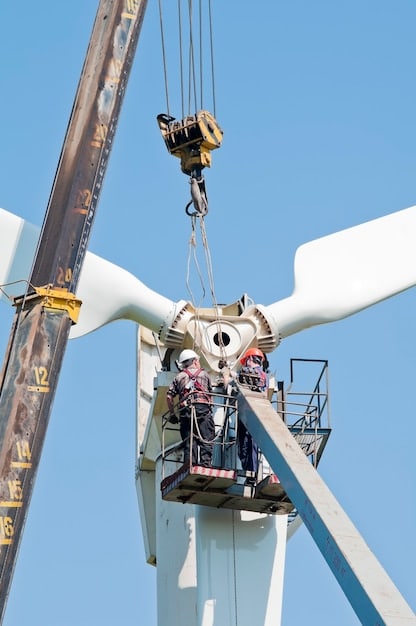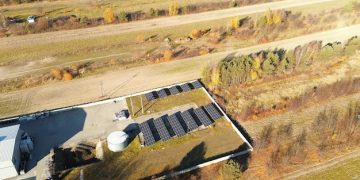Production Tax Credit: Impact on US Renewable Energy Manufacturing

The expansion of the Production Tax Credit (PTC) for renewable energy in the US is poised to significantly impact domestic manufacturing by incentivizing production, attracting investment, and fostering innovation within the clean energy sector.
The expansion of the Production Tax Credit (PTC) for renewable energy is set to reshape the manufacturing landscape in the United States. But how exactly will this incentive influence the sector? Let’s delve into the potential impacts and transformations that lie ahead, addressing How Will the Expansion of the Production Tax Credit for Renewable Energy Impact Manufacturing in the US?
Understanding the Production Tax Credit (PTC)
The Production Tax Credit (PTC) is a federal incentive designed to promote the generation of electricity from renewable resources. It provides a per-kilowatt-hour (kWh) tax credit for electricity generated using qualified energy resources. Originally introduced to support nascent renewable energy technologies, the PTC has become a cornerstone of US energy policy.
Initially focused on wind energy, the PTC has expanded over the years to include other renewable sources like biomass, geothermal, and hydropower. Facilities that generate electricity using these resources can claim the PTC for the first 10 years of operation. The primary goal is to reduce the cost of renewable energy, making it more competitive with traditional fossil fuels and encouraging greater investment in clean energy projects.
Key Features of the PTC
The PTC offers a financial incentive to electricity producers, lowering their operational costs and enhancing profitability. By reducing the financial risk associated with renewable energy projects, the PTC encourages developers to invest in new facilities and technologies. This support helps drive down the cost of renewable energy over time, benefiting consumers and the environment.
- Incentivizes renewable energy production by reducing operational costs.
- Attracts investment in new renewable energy facilities and technologies.
- Promotes competition between renewable and traditional energy sources.
The PTC has played a critical role in the growth of the renewable energy sector in the United States. It has enabled developers to secure financing, expand their operations, and deploy innovative technologies that would otherwise be too risky. As a result, the PTC has contributed to significant reductions in greenhouse gas emissions and increased energy independence.

Impact on Renewable Energy Manufacturing
The expansion of the Production Tax Credit (PTC) is poised to have a significant impact on the manufacturing sector in the United States. By making renewable energy projects more financially attractive, the PTC can stimulate demand for domestically manufactured components and equipment.
This increased demand can lead to job creation in factories across the country. Companies producing solar panels, wind turbines, and other renewable energy technologies may expand their operations or establish new facilities to meet the growing market. This, in turn, can boost local economies and strengthen the overall manufacturing base in the US.
Job Creation and Economic Growth
One of the most significant potential impacts of the PTC expansion is the creation of new jobs in the manufacturing sector. As demand for renewable energy technologies increases, companies will need to hire more workers to produce the components and equipment required for these projects. This can provide employment opportunities for both skilled and unskilled workers, helping to reduce unemployment rates and improve economic conditions in communities across the country.
- Increased demand for renewable energy technologies spurs job creation in manufacturing.
- Companies expand operations to meet market needs, boosting local economies.
- Creation of diverse employment opportunities for skilled and unskilled workers.
The expansion of the PTC can also lead to increased investment in research and development (R&D) within the manufacturing sector. Companies may allocate more resources to developing innovative technologies and improving the efficiency of their manufacturing processes. This can lead to further cost reductions, performance improvements, and competitive advantages for US manufacturers in the global market.
The expansion of the Production Tax Credit (PTC) is poised to have a significant impact on the manufacturing sector in the United States. By incentivizing renewable energy development, it can drive demand for domestically manufactured components and equipment, fostering job creation and economic growth.
Manufacturing of Solar Panels
Solar panel manufacturing stands to benefit significantly from the expanded Production Tax Credit (PTC). With increased incentives for solar energy projects, demand for solar panels is expected to rise, creating opportunities for domestic manufacturers.
The United States has the potential to become a major player in the global solar panel manufacturing industry. By leveraging the PTC and other policy measures, the country can attract investment, create jobs, and reduce its reliance on foreign suppliers.
Challenges and Opportunities
While the PTC offers significant opportunities for solar panel manufacturers, there are also challenges to overcome. One of the primary challenges is competition from overseas manufacturers, particularly those in China, which have lower labor costs and benefit from government subsidies.
- Competition from overseas manufacturers with lower labor costs.
- Need for investment in R&D to improve efficiency and reduce costs.
- Ensuring a stable and predictable policy environment to attract investment.
To succeed in the global solar panel market, US manufacturers must invest in R&D to develop more efficient and cost-effective technologies. They must also focus on quality and reliability to differentiate their products from those of their competitors. Additionally, a stable and predictable policy environment is essential to attract long-term investment and support the growth of the domestic solar panel industry.
The expansion of Production Tax Credit is set to boost the manufacturing of solar panels in the US. Creating opportunities for domestic production and competition within the global solar panel market.

Wind Turbine Component Manufacturing
Wind turbine component manufacturing is another area that can benefit greatly from the expansion of the Production Tax Credit (PTC). As wind energy projects become more economically viable, demand for wind turbines is expected to increase, creating opportunities for domestic manufacturers of turbine components.
The United States has a strong base of manufacturers that produce turbine blades, nacelles, towers, and other essential components. The PTC can help these companies expand their operations, create new jobs, and compete more effectively in the global market.
Supply Chain Considerations
One of the key considerations for wind turbine component manufacturers is the need to build a robust and reliable supply chain. Many of the components used in wind turbines are large and complex, requiring specialized manufacturing capabilities and skilled workers.
- Need to build a robust and reliable supply chain.
- Ensuring access to critical raw materials and components.
- Investing in workforce training and development to support manufacturing.
To ensure a stable supply of components, manufacturers must develop strong relationships with their suppliers and invest in workforce training and development. They must also ensure access to critical raw materials, such as steel, aluminum, and composite materials. By addressing these supply chain considerations, US manufacturers can position themselves for long-term success in the wind turbine market.
Wind turbine component manufacturing benefits from the Production Tax Credit(PTC) through the increase in demand in wind turbines. Creating a potential growth in domestic manufacturing.
Geothermal and Other Renewable Technologies
While solar and wind energy are the most well-known renewable technologies, the expansion of the Production Tax Credit (PTC) can also benefit geothermal and other renewable energy sources. These technologies have the potential to contribute significantly to the nation’s clean energy goals.
Geothermal energy, for example, is a reliable and consistent source of baseload power. It can provide electricity 24 hours a day, 7 days a week, unlike solar and wind, which are intermittent resources. By including geothermal in the PTC, policymakers can encourage greater investment in this valuable renewable energy source.
Incentivizing Niche Technologies
In addition to geothermal, the PTC can also incentivize the development of other niche renewable technologies, such as biomass, hydropower, and waste-to-energy. These technologies may not be as widely deployed as solar and wind, but they can play an important role in diversifying the nation’s energy mix and reducing greenhouse gas emissions.
- Promoting geothermal energy as a source of baseload power.
- Incentivizing niche renewable technologies like biomass and hydropower.
- Driving innovation and investment in a wide range of renewable energy sources.
By providing financial incentives for a wide range of renewable energy sources, the PTC can drive innovation and investment, leading to the development of new and improved technologies. This can help the United States become a leader in the global clean energy market and achieve its long-term environmental goals.
Expanding on solar and wind resources the Production Tax Credit will also aid geothermal energy and other renewable energy source. Diversifying green energy sources and driving towards long-term environmental goals.
Challenges and Considerations
While the expansion of the Production Tax Credit (PTC) offers many potential benefits for US manufacturing, there are also challenges and considerations to keep in mind. Policymakers, manufacturers, and other stakeholders must work together to address these challenges and ensure that the PTC is implemented effectively.
One of the key challenges is ensuring that the PTC benefits domestic manufacturers rather than foreign suppliers. To achieve this, policymakers may need to consider implementing domestic content requirements, which would require renewable energy projects to use a certain percentage of domestically manufactured components.
Policy and Implementation
In addition to domestic content requirements, policymakers may also need to address other policy and implementation issues, such as streamlining the permitting process for renewable energy projects and providing additional support for workforce training and development. These measures can help to create a more favorable environment for domestic manufacturers and ensure that the PTC has the greatest possible impact on the US economy.
- Ensuring that the PTC benefits domestic manufacturers over foreign suppliers.
- Streamlining the permitting process for renewable energy projects.
- Providing additional support for workforce training and development.
By addressing these challenges and considerations, policymakers can maximize the benefits of the PTC and help to create a thriving renewable energy manufacturing sector in the United States. This can lead to job creation, economic growth, and a cleaner, more sustainable energy future for the nation.
Successfully implementing the Production Tax Credit will result in the US economy growing. With proper support and development of renewable energy the US will create a cleaner more sustainable future.
| Key Point | Brief Description |
|---|---|
| 💡 PTC Expansion | Stimulates demand for renewable energy technologies. |
| 🏭 Manufacturing Boost | Encourages more domestics renewable energy manufacturing. |
| 🌎 Geothermal Incentives | Gives greater investments in geothermal technologies and cleaner energy. |
| 🛠️ Supply Chain Growth | Improves supply chain through investments . |
Frequently Asked Questions (FAQ)
▼
The Production Tax Credit (PTC) is a US federal tax credit for electricity generated by qualified renewable energy resources, such as wind, biomass, and geothermal. It provides a per-kilowatt-hour incentive for the first 10 years of a facility’s operation.
▼
The PTC stimulates demand for renewable energy equipment and components, fostering domestic manufacturing. This can lead to job creation, economic growth and attracts a lot more clean and green energy investments in the clean energy sector.
▼
The most benefited technologies by the expansion of the PTCs are solar panels, wind turbines, geothermal energy and biomass. This diversification can strengthens local economies
▼
Challenges include overseas competition, the requirement for domestic content, supply chain and implementation of effective policy creation to secure the greatest positive impact of green energy.
▼
Policymakers can implement domestic content requirements, streamline permitting, and invest in workforce development. These policies can guarantee the benefits of US economy and encourage the manufacturing sector.
Conclusion
In conclusion, the expansion of the Production Tax Credit (PTC) holds significant promise for transforming the manufacturing landscape in the United States by stimulating renewable energy production. By promoting job creation, economic growth, and technological innovation, the PTC is poised to drive the nation toward a cleaner, more energy independent future.





